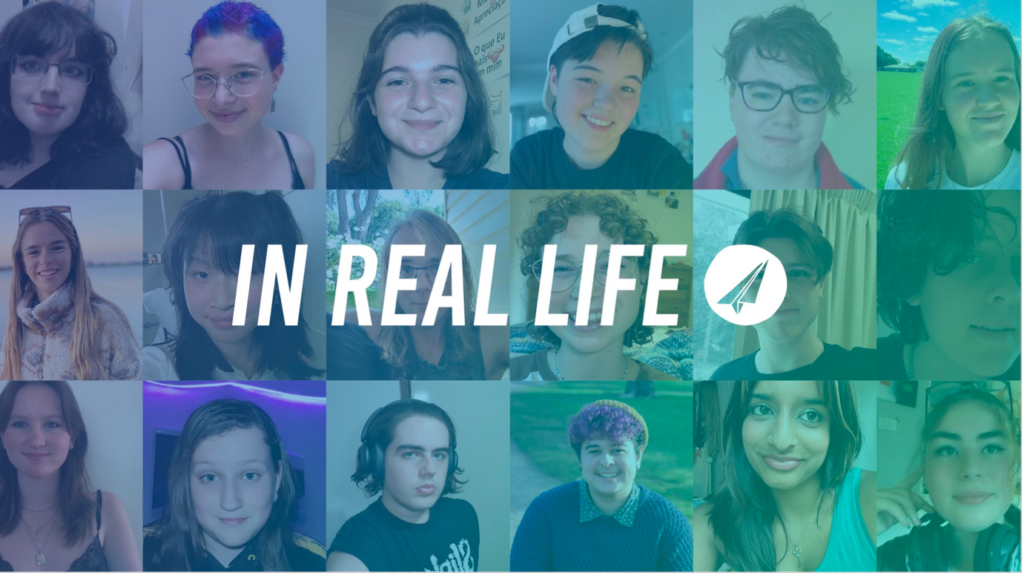As our digital lives continue to evolve into new mediums and devices, traditional online safety efforts are inevitably falling short. A new Aussie project, In Real Life, is re-imagining the landscape of online safety education by centering the perspectives of young people.

Reimagining Requires New Ways of Creating
For our team at PROJECT ROCKIT – Australia’s youth-driven movement against (cyber)bullying – elevating youth lived experience as expertise is central to our ability to remain relevant and impactful in an ever-changing social and digital landscape. Our latest initiative, In Real Life is the culmination of two such efforts: 1) A youth co-research study performed by our partners at the Young and Resilient Research Centre, Western Sydney University, and 2) Our subsequent participatory project showcasing youth experiences and perspectives in the language, style, framing, and format chosen by young people themselves. Made possible with funding from Australia’s eSafety Commissioner, the outcome is an innovative, free, youth co-designed digital storytelling resource for schools.
The youth-centered, participatory process facilitated by Young and Resilient generated a bold new direction for online safety education efforts, shared in the research report, Reimagining online safety education through the eyes of young people:
To better support young people, this new vision for (online) safety education decentres the extreme and the online. It focuses on the more routine, everyday safety issues young people deal with, and within which extreme risks are embedded. It also more explicitly acknowledges that online safety issues play out across both online and offline settings. (p. 5)
The Research
In partnering with Western Sydney University, we found common ground with a team equally valuing of genuine youth participation. Led by Professor Amanda Third, Young and Resilient researchers engaged a cohort of 12-17 year-olds in six online creative and participatory workshops, the research elevates youth lived experience as expertise on what is and isn’t working in online safety education. The key message? We have reached a point where we can no longer just tweak the edges of online safety education – we are now in need of a full overhaul.
Emerging from the co-research process is the stark disconnect between young people’s lived experience and current online safety narratives. In contrast to popular stereotypes of young teens as unengaged, passive consumers of digital technology, the research is full of verbatim youth commentary surfacing their nuanced understandings of online issues and a desire for sophisticated solutions that honor their agency and access to the benefits of technology while minimizing the harms. The research calls for a fundamental shift. Currently, adults are defining the problem and the solution, and in doing so tend to project their own fears and anxieties over the needs of young people. Instead, researchers advocate for approaches that “decentre extreme risks” and instead target the nuanced, peer-based, and relational issues that the majority teens are navigating daily.
Participatory approach: Beyond co-design
With the co-research evidence base in place, the next step was for PROJECT ROCKIT to assemble our creative team and transform these key learnings into innovative, youth-driven materials to best engage Aussie school students. Through a public call-out, 27 Youth Creators and Advisors aged 12–19 were onboarded, developed with storytelling skills and provided digital content creation kits. More importantly, a micro-community was established – through online meetings and a buzzing WhatsApp group – to generate youth-led conversations on the content that would form the basis of the In Real Life resource.
Our Youth Creators would connect and explore ideas via a variety of mediums from digital hangouts to rambling WhatsApp threads – with key moments of inspired commentary and storytelling filmed on their phones. Creative Advisors continued to review this content, make editorial decisions and spark further conversation to ensure that In Real Life remained true to the intended narratives of the young people involved.
Throughout the process, content creators and advisors shared a common refrain – that while bullying, grooming, and image-based abuse are critical issues, these topics are prioritized by agendas set by adults at the cost of the far more pressing daily issues and experiences with which they need truly need our support to navigate.
The strength of In Real Life is the authenticity of young people’s perspectives. We have fostered an atmosphere of truth-telling, banter and connection by taking the methodology of In Real Life as far up the participatory ladder as possible. To achieve this, we had to ensure that adults were divested of a range of decision-making power and that we provided young people with space to work as equals.
We did this in a range of ways that we present here for like-minded initiatives aiming to generate innovative youth-driven impact:
- Meet young people where they’re at
Engage across multiple platforms (online and offline) at times that suit young people. Do this by asking them where, when, and how they’d like to connect. - Value their time
Pay young people for their expertise (we paid $30-$40 per hour) and we needed to respect the differences between young people’s time and “project time”. This means things can take longer. That is ok. - Strive for ongoing engagement
Consultation is not a box tick. It’s including young people at all stages and levels of the project. Preferably as early as possible, and in different ways that will be at different levels of intensity. - Create safer spaces
Ensure you accommodate a range of needs and styles, but also don’t eliminate risk altogether. Small groups of around six work really well, with ongoing shared agreements about how to talk together. - Elevate diversity
Celebrate diversity and seek to reduce marginalization. Diversity strengthens the conversations and perspectives and means that the final outputs are more likely to resonate with the breadth and depth of young people’s lived experiences. - Hand over the mic
The decision-making process was deeply supported. We had to recognize that young people don’t have all the knowledge or understanding needed to make decisions on budgets or other decisions. This meant that we had to work closely together and if a decision they sought didn’t work within our constraints we had to explain that to the team, and seek other alternatives that would meet the goal of the young people – but in a different way.
The Result
The outcome of all of this, is an innovative digital storytelling resource, designed by young people for young people, with supporting teacher materials aimed at supporting students to have more nuanced and relevant conversations about their lives, especially in relation to digital and online experiences. The resource is free-to-access, live now, and ready to be injected into classrooms all over the world!
Join us in re-imagining the online world through the eyes of young people, by heading to www.projectrockit.com.au/IRL.

Lucy Thomas is a cofounder and CEO of PROJECT ROCKIT: Australia’s youth driven movement against bullying, hate and prejudice.

Daniel Donahoo is the Producer of IN REAL LIFE and Director at ideas consultancy, Project Synthesis.

